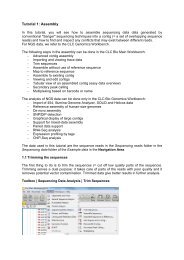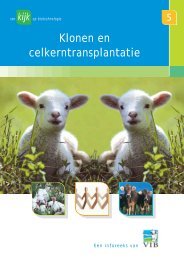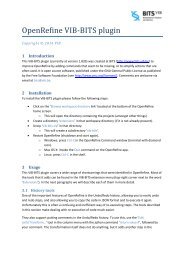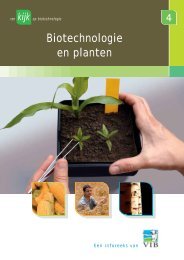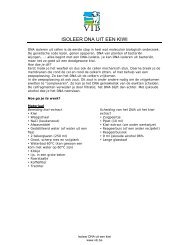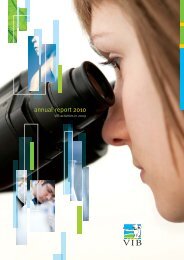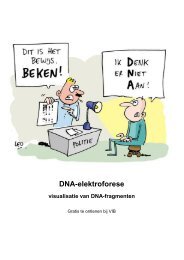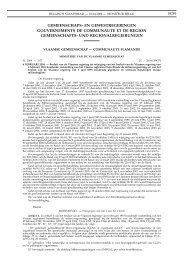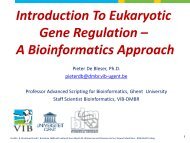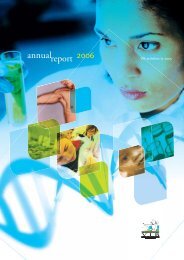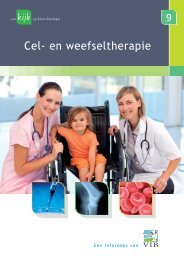Biosafety in the laboratory - VIB
Biosafety in the laboratory - VIB
Biosafety in the laboratory - VIB
You also want an ePaper? Increase the reach of your titles
YUMPU automatically turns print PDFs into web optimized ePapers that Google loves.
onment <strong>in</strong> a safety cab<strong>in</strong>et. Yeasts are airborne and able to survive <strong>in</strong> <strong>the</strong> air for long<br />
periods of time. In this way <strong>the</strong>y can contam<strong>in</strong>ate all k<strong>in</strong>ds of o<strong>the</strong>r cultures. In addition,<br />
sensitised people might suffer from allergic reactions after hav<strong>in</strong>g been exposed to yeast<br />
or its spores. For this reason, yeast is often manipulated <strong>in</strong> a separate <strong>laboratory</strong>.<br />
Waste<br />
All waste consist<strong>in</strong>g of or conta<strong>in</strong><strong>in</strong>g genetically modified yeasts should be <strong>in</strong>activated or<br />
decontam<strong>in</strong>ated.<br />
Note<br />
As was <strong>the</strong> case for E. coli, <strong>the</strong> organism will move one level up <strong>in</strong> both risk class and <strong>the</strong><br />
correspond<strong>in</strong>g measures to be taken when a gene that produces a hazardous substance,<br />
such as a tox<strong>in</strong>, is cloned <strong>in</strong>to <strong>the</strong> yeast.<br />
Work<strong>in</strong>g with genetically modified cell l<strong>in</strong>es<br />
Classification<br />
Classify<strong>in</strong>g animal or human cell l<strong>in</strong>es is not that simple. The determ<strong>in</strong><strong>in</strong>g factor is <strong>the</strong><br />
cells’ ability to produce hazardous biological agents, notably viruses. First of all a dist<strong>in</strong>ction<br />
should be made between primary cells and “established cell l<strong>in</strong>es”. Primary cells<br />
should at least be classified as L2 organisms. When established cell l<strong>in</strong>es are <strong>in</strong>volved, it<br />
should be determ<strong>in</strong>ed whe<strong>the</strong>r <strong>the</strong>y might produce virus particles, tak<strong>in</strong>g <strong>in</strong>to account any<br />
viral sequences that might be present <strong>in</strong> <strong>the</strong> vector be<strong>in</strong>g used <strong>in</strong> comb<strong>in</strong>ation with <strong>the</strong><br />
cell l<strong>in</strong>e. Some examples:<br />
Cell l<strong>in</strong>e Viral Vector (by way Classification* Classification Comments<br />
sequences of example only) rule**<br />
<strong>in</strong> cell l<strong>in</strong>e<br />
Primary Not known Not relevant L2 - Classification at a<br />
mouse cells<br />
lower level only<br />
upon proof that no<br />
hazardous biological<br />
agents are produced<br />
NIH-3T3 None SV40ori vector L1 4, e or j Zero risk of virus<br />
particle formation<br />
HELA E6E7 genes SV40ori vector L1 4, e or j Comb<strong>in</strong>ation of viral<br />
from HPV<br />
sequences <strong>in</strong> cell<br />
l<strong>in</strong>e and vector will<br />
not result <strong>in</strong> <strong>the</strong><br />
formation of virus<br />
particles<br />
Work<strong>in</strong>g with commonly used <strong>laboratory</strong> organisms 39



